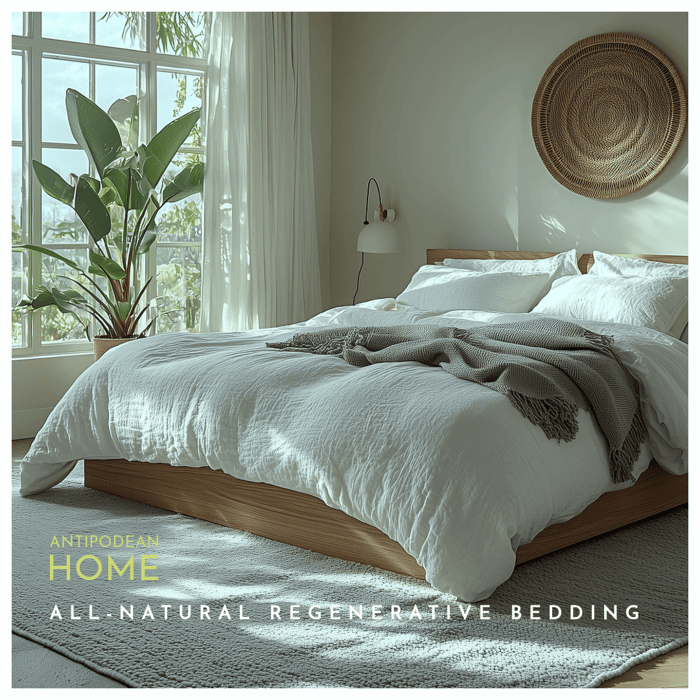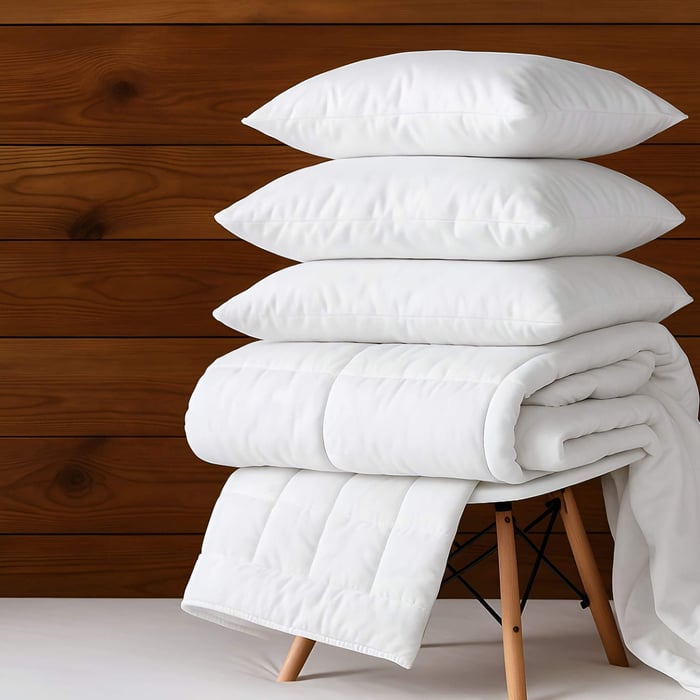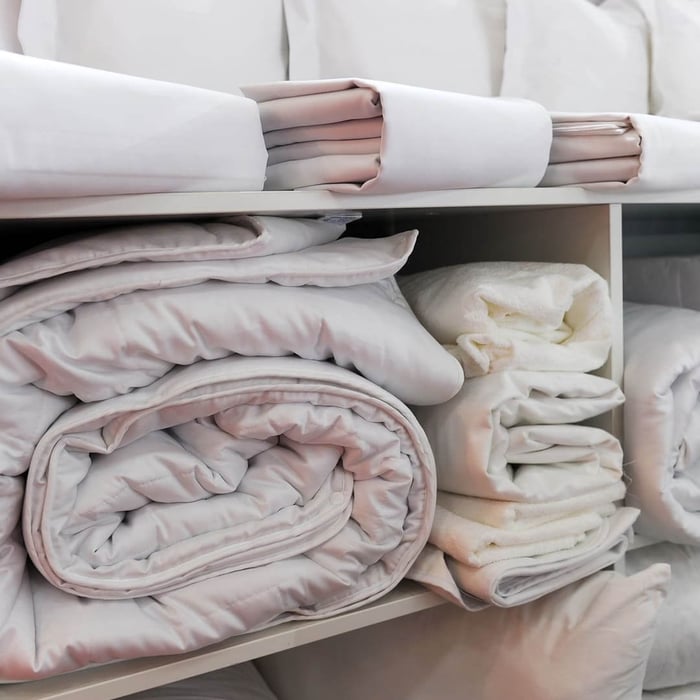Table of Contents
- A Tale of Two Comforters: Nature’s Luxury vs. Manufactured Warmth
- The Science of Wool Comforters: A Natural Luxury for the Best Sleep
- The Hidden Toxins in Synthetic Comforters
- The Synthetic Comforter Story: A Budget-Friendly Compromise
- The Breathability Test: Why Wool Outperforms Synthetics
- Why Wool Excels in Temperature Regulation
- Why Synthetics Fail the Test
- Durability Face-Off: The Investment That Lasts
- The Final Sleep Upgrade: Elevate Your Nights with a Wool Comforter
- FAQs on Wool Duvet Inserts, Comforters & Sustainable Bedding
A Tale of Two Comforters: Nature’s Luxury vs. Manufactured Warmth
Wool vs synthetic comforters—one is nature’s luxury, designed for effortless comfort and breathability, while the other is a budget-friendly alternative that struggles to keep up.
We’ve all been there—standing in the bedding aisle, weighing softness against sustainability, price against peace of mind. On one side, wool comforters, naturally breathable and temperature-balancing; on the other, synthetic comforters, often sold as down alternatives or microfiber bedding that promise the same plush feel for less.
But beneath that fluffy marketing lies a bigger story—one about comfort that fades, warmth that fluctuates, and materials that don’t breathe the way nature intended. As we spend nearly a third of our lives wrapped in what we sleep under, choosing between wool and synthetics isn’t just about comfort—it’s about what kind of rest, and what kind of world, we want to wake up to.
So, which one truly delivers the best sleep? Let’s find out.
Imagine settling into bed after a long day. You pull up your comforter, seeking that perfect balance of sumptuous warmth and breathable comfort. But the experience can be vastly different depending on what’s inside your bedding.
A wool comforter is nature’s luxury, offering effortless elegance and adaptive comfort, just as premium natural materials have for centuries. Meanwhile, a synthetic comforter traps heat and moisture, leaving you tossing and turning. The materials that cradle you in sleep matter more than you think—let’s explore why.The Science of Wool Comforters: A Natural Luxury for the Best Sleep
Wool vs synthetic comforters comes down to the difference between nature’s perfected insulation and mass-produced alternatives. Wool has been trusted for centuries to deliver warmth, breathability, and comfort without compromise.
Organic Wool Duvet Insert & Bedding Set | Sustainable & Regenerative | Made in New Zealand

$475.15
$559.00
Cooler Nights & Deeper Sleep — All Year Long Looking for the perfect organic wool duvet insert and wool bedding set? This complete bundle includes both the duvet insert and cover. (The insert uses the same breathable, temperature-regulating design as… Read more
From heirloom textiles to high-end outerwear, wool’s benefits extend perfectly into bedding.
- Microclimate Control: Wool’s crimped fibers create tiny air pockets, trapping warmth in winter and releasing heat in summer—keeping you effortlessly comfortable year-round.
- Moisture Mastery: Wool absorbs and wicks away moisture up to 30% of its weight before ever feeling damp, preventing that sticky, overheated feeling.
- Naturally Hypoallergenic & Pure: No chemicals, no synthetics—just a material that resists dust mites, mold, and allergens while feeling luxuriously soft against your skin.
Ever wake up kicking off the covers, only to grab them back minutes later? That’s your body fighting against your bedding. Wool prevents this by keeping your temperature stable so you sleep soundly—all night long, in effortless comfort.The Hidden Toxins in Synthetic Comforters
One of the biggest concerns with synthetic comforters is their use of chemicals and allergens.
Unlike wool, which is naturally hypoallergenic, synthetic bedding often contains formaldehyde, flame retardants, and petroleum-based fibers, which can release volatile organic compounds (VOCs) into the air. These chemicals have been linked to skin irritation, respiratory issues, and allergic reactions, making synthetic bedding a poor choice for those with sensitive skin or environmental concerns. Over time, as synthetic fibers break down, they release microplastics into your home, further reducing air quality and contributing to long-term exposure to harmful substances.
Additionally, many synthetic comforters are treated with perfluorinated chemicals (PFCs) to make them stain-resistant or water-repellent. These substances do not break down easily in the environment and have been associated with hormone disruption and other health concerns. Investing in a natural, chemical-free wool comforter is a healthier choice for both you and the planet.
The Synthetic Comforter Story: A Budget-Friendly Compromise
Wool vs synthetic comforters is also a question of longevity—while wool is built to last, synthetic materials break down quickly, losing their comfort and warmth.
Synthetic comforters were designed to cut costs and mass-produce warmth—but at what expense?
- Heat-Trapping Fibers: Polyester and microfiber lack natural breathability, meaning they hold onto body heat instead of dissipating it, creating a stifling, artificial warmth.
- Moisture Accumulation: Without wool’s moisture-wicking ability, synthetics can trap sweat, making you feel clammy and uncomfortable.
- Chemical Coatings & Fillers: Many synthetic comforters require chemical treatments to enhance softness or prevent odors, which can break down over time.
- Short-Term Fix: Synthetic fibers tend to clump, flatten, and degrade, meaning their warmth diminishes within just a few years.
While some high-end synthetics attempt to mimic wool’s performance, they often rely on temporary fixes like ventilation panels or artificial wicking treatments that lose effectiveness over time.
The Breathability Test: Why Wool Outperforms Synthetics
Wool vs synthetic comforters is more than just about warmth—it's about airflow, breathability, and night-long comfort.
If you’ve ever woken up feeling overheated and damp, your comforter is likely working against you.Why Wool Excels in Temperature Regulation
- Absorbs & Releases Moisture: Wool ensures you stay dry, cool, and comfortable all night.
- Adapts to Your Needs: Unlike synthetics, wool naturally adjusts to external temperatures.
- Perfect for Hot Sleepers & Night Sweats: Wool prevents the cycle of overheating, sweating, and waking up uncomfortable.
 Wake up refreshed under our regenerative wool comforter — naturally breathable, temperature-balancing, and crafted for comfort that lasts year after year.
Wake up refreshed under our regenerative wool comforter — naturally breathable, temperature-balancing, and crafted for comfort that lasts year after year.Why Synthetics Fail the Test
- Traps Heat & Moisture: Without proper ventilation, synthetics create a stuffy, suffocating sleep environment.
- Lacks Natural Adaptability: Unlike wool, synthetic fibers can’t adjust to changing temperatures, meaning you might feel too hot or too cold in the same night.
- Absorbs Odors & Bacteria: Moisture gets trapped inside synthetic materials, leading to stale smells and bacteria buildup over time.
Sleeping under synthetics is like wearing plastic—cheap, inefficient, and uncomfortable. Wool, by contrast, is a natural indulgence that supports your body’s ideal sleep cycle.Durability Face-Off: The Investment That Lasts
Wool vs synthetic comforters isn’t just about what feels best—it’s about what lasts. Wool provides long-term value, while synthetic bedding quickly loses its appeal.
A comforter should be a long-term investment in better sleep. Here’s how wool and synthetic compare:
Wool: Designed to Last Decades
- Naturally resilient fibers maintain their loft and structure for 20+ years.
- Mold & dust-mite resistant, extending its lifespan.
- Requires minimal upkeep—just occasional airing out keeps it fresh.
Synthetics: Disposable Bedding
- Fibers break down quickly, leading to flattened insulation.
- Frequent washing weakens synthetic fill, reducing warmth.
- Typically needs replacement within 5-7 years.
While synthetics might seem cost-effective, they lose performance quickly, requiring multiple replacements—costing you more in the long run.
While synthetics trap heat, wool manages it. See a deeper comparison of how natural fibers outperform polyester in our comprehensive guide to Wool Comforters & Wool Duvets.
 Rest easy under Antipodean Home’s all-natural regenerative bedding — crafted in New Zealand from pure organic wool that keeps you cool in summer and cozy in winter.
Rest easy under Antipodean Home’s all-natural regenerative bedding — crafted in New Zealand from pure organic wool that keeps you cool in summer and cozy in winter.The Final Sleep Upgrade: Elevate Your Nights with a Wool Comforter
Wool vs synthetic comforters comes down to a choice between natural luxury and temporary convenience. If you want a bedding upgrade that truly enhances sleep, wool is the answer.
If you’re looking for better sleep, not just more warmth, it’s time to rethink your bedding.
Wool doesn’t just provide warmth—it actively regulates your body temperature, wicks away moisture, and lasts for years without losing quality. Unlike synthetics, which merely imitate comfort, wool is the real thing—a naturally luxurious material, crafted for effortless, breathable, and deeply restorative sleep.So, if you’re ready to upgrade your nights, it’s time to choose nature’s luxury. Experience the indulgence of a wool comforter today. 🌙✨
Learn More About Our Wool Bedding Collection
FAQs on Wool Duvet Inserts, Comforters & Sustainable Bedding
Does wool really stay warm in winter and cool in summer?
Yes — wool fibers naturally trap air and adjust to ambient temperature. They insulate when it’s cold, yet release heat when you get warm, helping maintain a steady, comfortable sleep climate.
Are synthetic comforters cheaper in the long run?
Not necessarily. Synthetics tend to lose loft, flatten, or degrade within 5–7 years, often requiring replacement. Wool comforters, by contrast, can last decades with good care.
Do synthetic comforters release harmful chemicals?
They can. Many synthetic comforters use flame retardants, VOC-emitting finishes, or chemical coatings. Wool is naturally fire-resistant and typically chemical-free.
Which option is better for hot sleepers or night sweats?
Wool tends to win here. Its moisture-wicking and breathability properties help prevent overheating, whereas synthetics can trap heat and sweat close to your body.
How do I care for a wool comforter vs a synthetic one?
Wool comforters usually require gentle airing, occasional spot cleaning, and a breathable duvet cover. Synthetic fills are often more machine-wash–friendly but degrade faster with washing.




